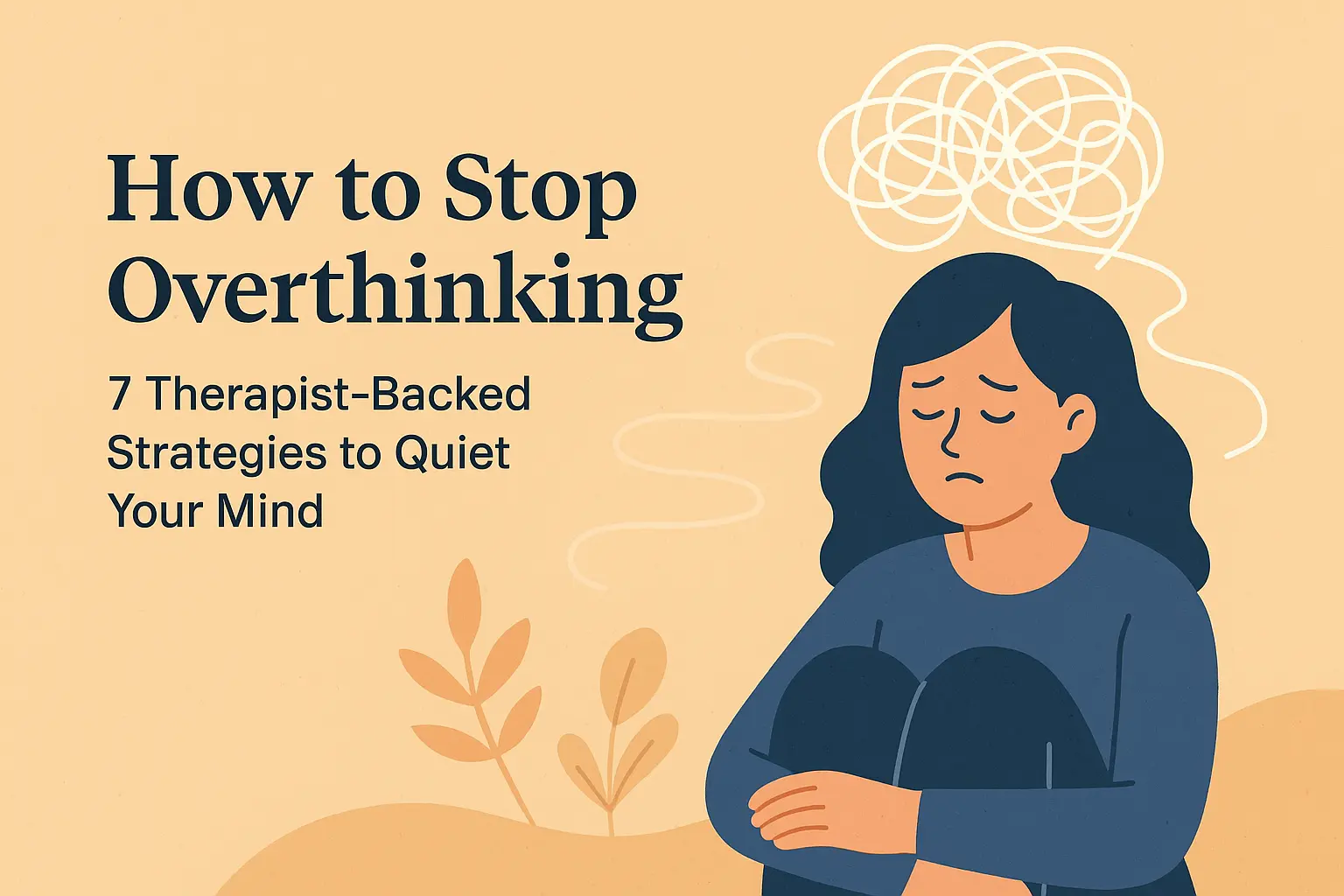If your brain has ever felt like it’s stuck on a hamster wheel — replaying past mistakes, rehearsing future disasters, or spiraling on “what-ifs” — you already know how exhausting overthinking can be.
It feels like you’re “doing something” by thinking it through, but really you’re just draining your energy, losing sleep, and staying stuck. Overthinking doesn’t lead to clarity; it leads to paralysis.
The good news? There are skills you can use to interrupt the cycle, quiet your mind, and get back into the present moment.
That’s exactly why I created the Overthinking Survival Kit — a free, therapist-designed starter pack filled with printables and exercises you can use anytime overthinking hijacks your brain.
In this post, I’ll share seven strategies straight from the Overcoming Overthinking, Rumination, and Intrusive Thoughts Workbook. They’re practical, easy to remember, and most importantly — they actually work.
What Overthinking Really Is (and Why It Feels Endless)
First, let’s normalize what’s happening in your brain.
- Overthinking: replaying or predicting scenarios, often with a “what if” loop.
- Rumination: replaying past mistakes, regrets, or arguments.
- Intrusive thoughts: random, often distressing mental images or ideas that pop up uninvited.
These loops happen because your brain is trying to protect you. It thinks, “If I keep analyzing this, I’ll figure it out.” But instead of solving problems, overthinking usually just magnifies fear and uncertainty.
That’s why the goal isn’t to “stop thinking” (that’s impossible). The goal is to change your relationship with your thoughts — so they no longer run the show.
1. How to Recognize When You’re Overthinking
The first step is awareness. Many people don’t notice they’re spiraling until they’ve been stuck in their head for hours.
Signs you’re caught in a thought loop:
- You keep replaying the same conversation or mistake.
- You’re stuck between choices and can’t decide.
- You’re imagining every worst-case scenario.
- You feel mentally tired but no closer to an answer.
👉 Try this mini exercise: Next time you notice yourself stuck, jot down what triggered the loop and how it shows up in your body (tight chest, racing heart, restlessness). This helps you “catch” overthinking before it snowballs.
2. A Simple Way to Stop Catastrophic Thinking
Catastrophic thoughts love to whisper: “What if everything goes wrong?”
One of the most effective ways to break the spiral is the Best-Case / Worst-Case / Most-Likely Scenario method.
- Write down the absolute worst thing that could happen.
- Write down the absolute best thing that could happen.
- Then ask: “What’s the most realistic outcome here?”
This balances your perspective and keeps fear from running wild.
👉 Bonus tip: Pretend your best friend came to you with this thought. What advice would you give them? Often, it’s gentler and more rational than the advice you give yourself.
3. How to Stop Replaying Past Mistakes
Rumination often sounds like: “Why did I say that?” or “I should’ve done it differently.”
The problem? Rumination keeps you in the past, where you can’t change anything.
Instead, try reframing: What can I learn from this?
👉 Example: Instead of replaying how you snapped at your partner, reframe it as: “This shows me I need better boundaries when I’m tired. Next time I’ll take a break before I talk.”
Reframing isn’t toxic positivity — it’s shifting from shame to growth.
4. What to Do With Intrusive Thoughts That Won’t Go Away
Here’s the truth: Everyone has intrusive thoughts. They can be weird, random, or even disturbing — but they are not reflections of who you are.
The trick is not to wrestle with them. Fighting them usually makes them louder. Instead:
- Label the thought: “This is just a thought, not a fact.”
- Imagine it as a cloud passing across the sky.
- Let it float by without engaging.
👉 If it helps, write the intrusive thought on paper, then crumple it up and toss it. That physical release signals to your brain: we don’t need to hold onto this.
5. How to Contain Worry Before It Takes Over Your Day
If you’re a chronic worrier, your brain can hijack every spare moment. That’s why one of my favorite tools is Worry Time Scheduling.
Here’s how:
- Pick a specific 15-minute window each day to do your worrying.
- Anytime a worry pops up, tell yourself: “Not now. I’ll think about it at 7 PM.”
- Write it down and return to it later.
Often, by the time worry hour comes, half your “urgent” thoughts won’t even feel relevant. And the ones that do? You can address with more calm and clarity.
6. How to Let Go of Thoughts Without Fighting Them
One of the most freeing skills is what I call Catch & Release.
When you notice yourself tangled in a thought:
- Pause and say: “I’m noticing I’m having this thought.”
- Picture it as a leaf floating down a stream or a balloon drifting upward.
- Watch it go without trying to argue with it.
This practice helps you build distance between you and your thoughts — so they no longer feel like absolute truth.
7. The Key to Building Long-Term Mental Clarity
Here’s the secret: one-off tricks are useful, but the real magic comes from building new thought habits over time.
That might mean:
- Pairing a skill with your morning coffee.
- Practicing a “thought release” every night before bed.
- Celebrating small wins: “I caught one spiral today — that’s progress.”
Your brain learns through repetition. The more often you practice these small skills, the more automatic they become — until overthinking loosens its grip on your life.
Free Resource: The Overthinking Survival Kit
Reading these skills is a great first step — but practicing them is what changes your brain. That’s why I created the Overthinking Survival Kit.
It’s a free set of printable worksheets and exercises you can use anytime overthinking hijacks your day. Inside, you’ll find:
- Step-by-step guides for catching spirals
- Printable worry scheduling sheets
- Quick reframing prompts you can stick on your desk
The Survival Kit is your starter pack — and if you love it, you’ll want to check out the Overcoming Overthinking, Rumination, and Intrusive Thoughts Workbook, which takes you even deeper with exercises, strategies, and guided practice.
Final Thoughts
Overthinking doesn’t mean you’re broken. It means your brain is trying too hard to protect you.
By learning to notice thought spirals, reality-check them, and let them go, you can create more mental space for what actually matters: living your life, not analyzing it.
You don’t need to stop thinking. You just need to build a healthier relationship with your thoughts.
👉 Ready to start? Download your free Overthinking Survival Kit today and take your first step toward a calmer mind.







